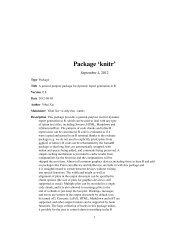Package 'openair'
Package 'openair'
Package 'openair'
You also want an ePaper? Increase the reach of your titles
YUMPU automatically turns print PDFs into web optimized ePapers that Google loves.
134 trajClustertypecolssplit.aftertype determines how the data are split i.e. conditioned, and then plotted. Thedefault is will produce a single plot using the entire data. Type can be one ofthe built-in types as detailed in cutData e.g. “season”, “year”, “weekday” andso on. For example, type = "season" will produce four plots — one for eachseason. Note that the cluster calculations are separately made of each level of"type".Colours to be used for plotting. Options include “default”, “increment”, “heat”,“jet” and RColorBrewer colours — see the openair openColours functionfor more details. For user defined the user can supply a list of colour namesrecognised by R (type colours() to see the full list). An example would becols = c("yellow", "green", "blue")For type other than “default” e.g. “season”, the trajectories can either be calculatedfor each level of type independently or extracted after the cluster calculationshave been applied to the whole data set.... Other graphical parameters passed onto lattice:levelplot and cutData. Similarly,common axis and title labelling options (such as xlab, ylab, main) arepassed to levelplot via quickText to handle routine formatting.DetailsTwo main methods are available to cluster the back trajectories using two different calculationsof the distance matrix. The default is to use the standard Euclidian distance between each pairof trajectories. Also available is an angle-based distance matrix based on Sirois and Bottenheim(1995). The latter method is useful when the interest is the direction of the trajectories in clustering.The distance matrix calculations are made in C++ for speed. For data sets of up to 1 year bothmethods should be relatively fast, although the method = "Angle" does tend to take much longerto calculate. Further details of these methods are given in the openair manual.ValueReturns original data frame with a new (factor) variable cluster giving the calculated cluster.Author(s)David CarslawReferencesSirois, A. and Bottenheim, J.W., 1995. Use of backward trajectories to interpret the 5-year recordof PAN and O3 ambient air concentrations at Kejimkujik National Park, Nova Scotia. Journal ofGeophysical Research, 100: 2867-2881.See AlsoimportTraj, trajPlot, trajLevel
















